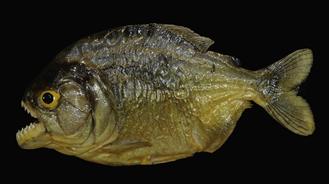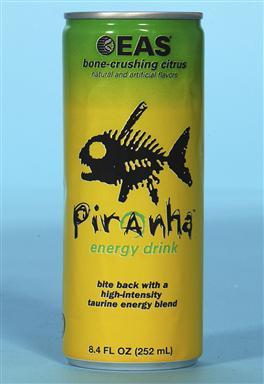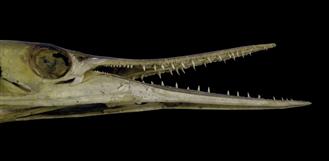1
The Jaws of the Piranha
Natural History of the Piranha
The fearsome reputation of the piranha is matched today only by that of the great white shark, all the more impressive given the piranha’s diminutive size (usually between 15 and 25 cm in length; Figure 1.1) compared to several metres of shark. Unlike the shark, piranhas usually attack prey larger than themselves.

Figure 1.1 A 19-cm long piranha showing the general body features. Note the deep-bodied outline, the forward-jutting lower jaw and the wide gape of the jaws.
The piranha’s aggressive image has proved highly marketable, giving its name to, among other things, a thirst-slaying, fizzy drink with its ‘bone-crushing citrus’ (Figure 1.2); a U.S. women’s ice hockey team, the ‘Pittsburgh Piranhas’; and two well-known rock bands.

Figure 1.2 A can containing a fizzy drink called Piranha with the logo ‘bone-crushing citrus’.
Piranhas have also inspired Hollywood. In the 1978 cult horror film Piranha, a shoal of piranhas, genetically engineered by the military to be oversized, fast-breeding and flesh-crazy, is accidentally released into a river leading to a holiday resort, with predictably gory results. In the 2010, 3-D film Piranha, a shoal of piranhas thought to be extinct for over 2 million years is released from an underground lake into a river following an earthquake. They reach a town where a large number of teenagers, swimming in the river, meet with a violent end. In the James Bond film You Only Live Twice, supervillain Ernst Stavro Blofeld feeds one of his female agents to his pet piranhas as a punishment for failing to kill Bond.
Much ferocious piranha behaviour has been wildly exaggerated. Of the more than 30 different species, many do not kill other fish, but merely ‘graze’ off them, taking small pieces of the fin or scales, which will later regenerate. Some are vegetarians. Only a few species are considered fierce and aggressive. Attacks on humans are extremely rare, and deaths are virtually unknown. Amazonian children swim quite safely in streams and rivers inhabited by piranhas, as has the occasional intrepid, documentary filmmaker. A recent exception occurred in 2002 in southeast Brazil, where over 50 attacks were recorded (the most serious requiring a toe amputation). This unusual aggression seemed to be a consequence of damming the local river for flood protection, resulting in a large number of understandably irritable piranhas being trapped in the still waters, compared with the flowing white waters of their native environment.
The giant feeding frenzy is also a myth: some piranhas hunt individually, whereas shoals typically contain only 20–30 individuals. Piranhas tend to pair up when swimming in shoals, and if there is an odd number of fish, the unlucky unpaired single one may be eaten by its fellows. Although previously regarded as an attacking strategy, recent research has suggested that shoaling behaviour may also represent a defence against predators (i.e. safety in numbers).
Piranhas are bony fish belonging to the genus Serrasalmus, meaning saw salmon and referring not to the teeth but to the notched appearance of the enlarged scales running in the midline across the belly. The origin of the word piranha is uncertain but may be derived from a local Amazonian tribal word meaning either toothed fish or scissors. In support of the latter, piranha jaws are used as cutting or shearing tools, even being employed to cut hair or to sharpen poisonous darts.
Although their main prey is other fish, piranhas are opportunistic and will eat whatever is available. Analysis of their stomach contents reveals insects, crustaceans, molluscs, lizards and rodents. As the rivers flood into the forests, piranhas incorporate seeds and other vegetable matter into their diet. Like carnivorous predators on the African savannah, piranhas seek out and dispatch the weak and injured animals in Amazonian rivers. Their extreme sensitivity to the scent of blood helps them in this pursuit. Birds, such as young herons and egrets, falling from their nests into the river below supplement the piranha diet.
Piranhas themselves have many predators such as larger fish, birds, caiman, freshwater dolphins, turtles and the indigenous people. A new tourist attraction of piranha fishing is being promoted. In the dry season, piranhas may become concentrated in isolated, shrinking, shallow pools that provide particularly rich pickings for fish-eating birds (including herons).
Teeth of the Piranha
The success of piranhas in obtaining food depends not only upon cooperating as a pack, like wolves, but also in their possession of an extremely specialised set of teeth. The unique arrangement of their teeth makes the piranha very effective as a predator. Whereas the majority of fish have large numbers of teeth (in many instances reaching a hundred or more, as in the barracuda; see Figure 4.10), the piranha has an upper row of only six and a lower row of seven on each side, and this number is retained throughout their life. Unlike most fish, whose teeth are conical and spaced out (Figure 1.3), piranha teeth are sharp, triangular, narrow and bladelike with razor-sharp edges and are in contact with each other (Figures 1.4 and 1.5). In addition to the central, prominent, main cusp, there is a small cusp at the back of each tooth, which slots neatly into a depression at the front of the tooth behind. This results in the teeth being totally interlocked (Figures 1.5 and 1.6). Instead of a number of separate teeth in each jaw, each piranha jaw could be considered as containing a single, continuous, serrated cutting edge.

Figure 1.3 The teeth of the short-nosed gar fish. Note the large number of spaced, conical teeth, with gaps along the dentition where replacing teeth will soon erupt.
Source: Courtesy of the Hunterian Museum at the Royal College of Surgeons.
Stay updated, free dental videos. Join our Telegram channel

VIDEdental - Online dental courses



